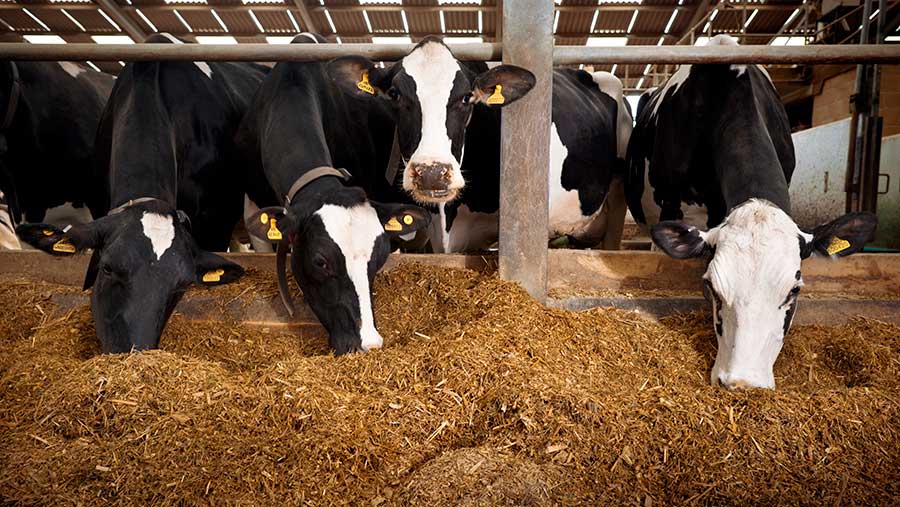Dairy farms race to stay ahead of rising production costs
 © Jim Varney/Science Photo Library
© Jim Varney/Science Photo Library Profitability in the dairy industry is stagnating, despite farmers’ best efforts to find efficiency savings, according to a new report.
The latest industry analysis by consultancy firm Kingshay found margins over purchased feed had risen by almost 25% on average in the past 10 years to £1,704 a cow as farms have made better use of forage and bought-in feed.
However, these gains are being swallowed up by rising costs of production in other areas, leaving bottom-line profitability at a similar level to 2010, said Kathryn Rowland, senior farm services manager at the firm.
“Margins [over purchased feed] increased despite rises in purchased feed costs, likely mitigated by increases in yield, milk from forage and milk price, but other costs of production, such as labour, will also have increased over that period,” she said.
See also: How a dairy farmer cut electricity costs by £2,000 a year
The report found there is no one system that is more profitable than the others, but the best 25% of operators in each system are strongly outperforming the rest.
It looked at efficiency in five common conventional production systems, including year-round and block-calving setups on both housed and grazing-focused systems.
In the past year, for the year-round-calving, housing-focused systems, there was a range in margins over purchased feed of £2,219 a cow for the top 25%, to £1,465 for the bottom 25%.
This translates to a difference of £150,800 for a 200-cow herd – now the average herd size after a drop in numbers for a second year, down from a peak of 210 in 2017.
The financial period under study was the year ending March 2020, which means most of the effects of the coronavirus crisis will not have been felt.
In spring block-calving, grazing-focused herds, which concentrate more on margin/litre, the margin over purchased feed ranged from 28.3p/litre for the top 25% to 16.9p/litre for the bottom 25%.
Total milk produced from grass saw a 3% increase on average across all farms in 2019-20 to 32.9% of yields (2,759 litres), as growth increased sharply on the previous year, when there was a summer drought.
Kingshay says focusing on performance from forage could offer a way for farmers to protect against lower milk prices or varying input costs.
It describes the variation in amount of milk produced from forage on farms as staggering, with the top quartile of forage-focused farmers producing 48.6% from forage, while the bottom quartile only averaged 15.4%.
This directly correlates to margins over purchased feed, meaning many producers could add to their bottom line by improving their forage management and use.
Financial reward for health focus
Costs are also being driven down in top-performing herds by improving cattle health, with the best 25% of farms spending £12,327 less per 100 cows than the average farm.
This was chiefly achieved by keeping mastitis cases down to half the incidence rate of the average, with the best seeing only 18 cases per 100 cows compared with an average of 36, saving an estimated cost of £261 a case.
Lameness rates were also significantly lower, along with interventions for fertility-related issues such as difficult calvings, retained cleansings and abortions.
Ms Rowland said the effort of compiling large datasets to benchmark a farm against similar systems is justifiable, as it will highlight areas where improvements can be made.
“The important thing to take on board is that any dairy system can be profitable, but it requires a focus on efficiencies across the board; from forage, to health, fertility and other inputs,” she said.
Milk price update
Dairy processor Meadow Foods announced this week that it will be increasing its A-litre milk price by 1p/litre to 26p for farmers located in Cumbria, Lancashire and South Wales, backdated to 1 July.
The move will see producers in those regions return to a parity with the processor’s suppliers in Cheshire, Shropshire, Staffordshire, North Wales, Derbyshire, Worcestershire and Yorkshire.
The two groups had been on separate prices since March, when the processor reportedly lost a key contract to supply milk to Arla.
Mark Chantler, chief executive of Meadow Foods, said: “We previously promised that as soon as we were able to achieve better prices, we would pass the benefit back to our producers, and we are pleased to do that.
“Although the market has improved recently, there remains uncertainty and we will continue to monitor the markets closely and hope to be able to pass any further improvements on to producers as soon as possible.”
Meadow Foods joins a number of other processors that have increased prices in the past month, including Grahams Dairy and Medina Foods, as the sector gradually recovers from the effects of the coronavirus shutdown.
